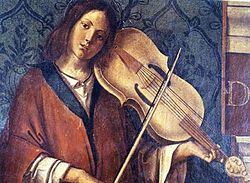 "Lyra de bracio" as illustrated by Michael Praetorius in his Syntagma Musicum | |
| Other names | Lyra de bracio |
|---|---|
| Classification | Bowed string instrument |
| Developed | 15th century |
| Related instruments | |
| Lirone Vielle | |
The lira da braccio (or lira de braccio or lyra de bracio [1] ) was a European bowed string instrument of the Renaissance. It was used by Italian poet-musicians [2] in court in the 15th and 16th centuries to accompany their improvised recitations of lyric and narrative poetry. [3] It is most closely related to the medieval fiddle, or vielle, [4] and like the vielle had a leaf-shaped pegbox with frontal pegs. [3] Fiddles with drone strings are seen beginning in the 9th century (Byzantine lyra), and the instrument continued to develop through the 16th century. [3] In many depictions of the instrument, it is being played by mythological characters, frequently members of angel consorts, and most often by Orpheus and Apollo. The lira da braccio was occasionally used in ensembles, particularly in the intermedi , and may have acted as a proto-continuo instrument.
Contents
The instrument was shaped essentially like a violin, but with a wider fingerboard and flatter bridge. Generally, it had seven strings, five of them tuned like a violin with a low d added to the bottom (that is, d–g–d'–a'–e'') with two strings off the fingerboard which served as drones and were usually tuned in octaves. [3] Michael Praetorius shows the instrument with frets, although he is the only one to do so (see image at right). The wide fingerboard and flat bridge, along with long, strongly curved bows, facilitated chordal playing on the instrument. Although Praetorius depicts the instrument as lyra de bracio with various viols "da gamba" (see image), [1] it was in fact played on the shoulder, as is implied by its name, which refers to the arm, or braccio in Italian. From the few treatises and compositions which survive, it seems that the lira was played with triple and quadruple stops. The player was somewhat limited in terms of what inversions they could play, and it is believed that the top strings may have been used for melody, and the lower strings for chordal playing. In addition, it is believed that when accompanying singing, the instrument played at a higher pitch than the performer sang. [3] Eventually in the late 16th century a fretted bass version of the lira da braccio with an expanded number of strings was developed, the lirone , also known as the lira da gamba, which was played "da gamba", or between the legs.

